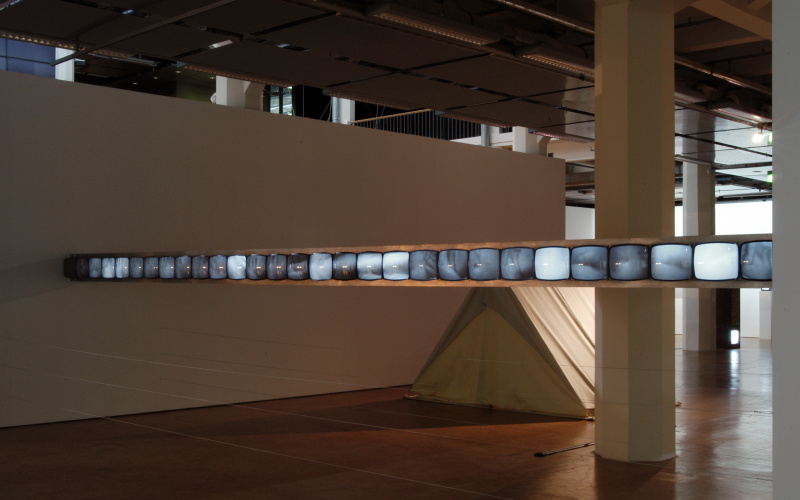- Event
- Opening
Masterpieces of Media Art from the ZKM Collection
Sat, September 18, 2004 8:00 pm CEST
- Location
- ZKM | Media Museum
The ZKM Collection, which was begun in 1989, can now justifiably be regarded as having set a trend for many other later collections. It was the first to adopt a new exemplary approach to the different media and genres of art. From the very outset the idea underlying the ZKM’s attitude to collecting was that the genres should be broken up. Purchasing policy was not focused on art as a medium of expression. On the contrary, the aim was to set up a museum for all media and genres with all art media being placed on an equal footing. One key feature underlying the difference between the media arts and the classical arts is to be found in Lessing’s »Laocoon or The Limits of Painting and Poetry« [1766]. In his concept of aesthetics, the classical arts of panel painting and sculpture were defined as interior decoration. As we know, moving pictures and video installations are forms of contemporary art. The associated changes in the culture of reception – how do visitors respond to an interactive work?; how long will they watch a video tape? – constituted a risk that Heinrich Klotz and the ZKM were prepared to take. In doing so, they assumed a pioneering role among German museums. It is only logical, therefore, that many works in the collection should ask questions about time.
»Tempo Liquido« [Liquid Time] was the title given in 1993 by the Italian artist, Fabrizio Plessi – to whom a much-acclaimed retrospective was devoted in Berlin’s Martin Gropius Building in spring 2004 – to a work that has become one of the most popular symbols of the ZKM Collection. The five-metre tall waterwheel, which feeds endless amounts of virtual blue liquid into real bubbling water in a broad steel basin, has been reinstalled by popular demand. In his large-scale installation »The City of Man« [1989] the American video pioneer, Bill Viola, who in recent years has exhibited his works in the world’s major museums from London to New York, produces pictures of life and death in the traditional from of an altar triptych. »The Virtual Museum« by Jeffrey Shaw [1991] demonstrates the essence of what the new media have contributed to art – the dissolution of the old coordinates of time and space. The selection of incunabula, including works by other media artists of world renown, such as Bruce Naumann, Steina Vasulka, Rebecca Horn, Gordon Matta-Clark, Wolf Vostell, Nam June Paik and Marie Jo Lafontaine, is supplemented by special environments, in which three large database installations provide access to the history of media art. The audiovisual treasures, which up to now were primarily open for research purposes in the ZKM Media Library, are now accessible to a broad public thanks to new interface technologies. For the first time, developments and works from all the ZKM institutes can be presented to the public in appropriate surroundings. They include a panorama of media art from the early days in the 1950s up to modern net art, curated by Peter Weibel and Barbara Könches, which no other museum in the world has to offer.
»Tempo Liquido« [Liquid Time] was the title given in 1993 by the Italian artist, Fabrizio Plessi – to whom a much-acclaimed retrospective was devoted in Berlin’s Martin Gropius Building in spring 2004 – to a work that has become one of the most popular symbols of the ZKM Collection. The five-metre tall waterwheel, which feeds endless amounts of virtual blue liquid into real bubbling water in a broad steel basin, has been reinstalled by popular demand. In his large-scale installation »The City of Man« [1989] the American video pioneer, Bill Viola, who in recent years has exhibited his works in the world’s major museums from London to New York, produces pictures of life and death in the traditional from of an altar triptych. »The Virtual Museum« by Jeffrey Shaw [1991] demonstrates the essence of what the new media have contributed to art – the dissolution of the old coordinates of time and space. The selection of incunabula, including works by other media artists of world renown, such as Bruce Naumann, Steina Vasulka, Rebecca Horn, Gordon Matta-Clark, Wolf Vostell, Nam June Paik and Marie Jo Lafontaine, is supplemented by special environments, in which three large database installations provide access to the history of media art. The audiovisual treasures, which up to now were primarily open for research purposes in the ZKM Media Library, are now accessible to a broad public thanks to new interface technologies. For the first time, developments and works from all the ZKM institutes can be presented to the public in appropriate surroundings. They include a panorama of media art from the early days in the 1950s up to modern net art, curated by Peter Weibel and Barbara Könches, which no other museum in the world has to offer.
Imprint
- Curator
- Curator
Organizing Organization / Institution
ZKM
This Event - Is part of
Accompanying program
